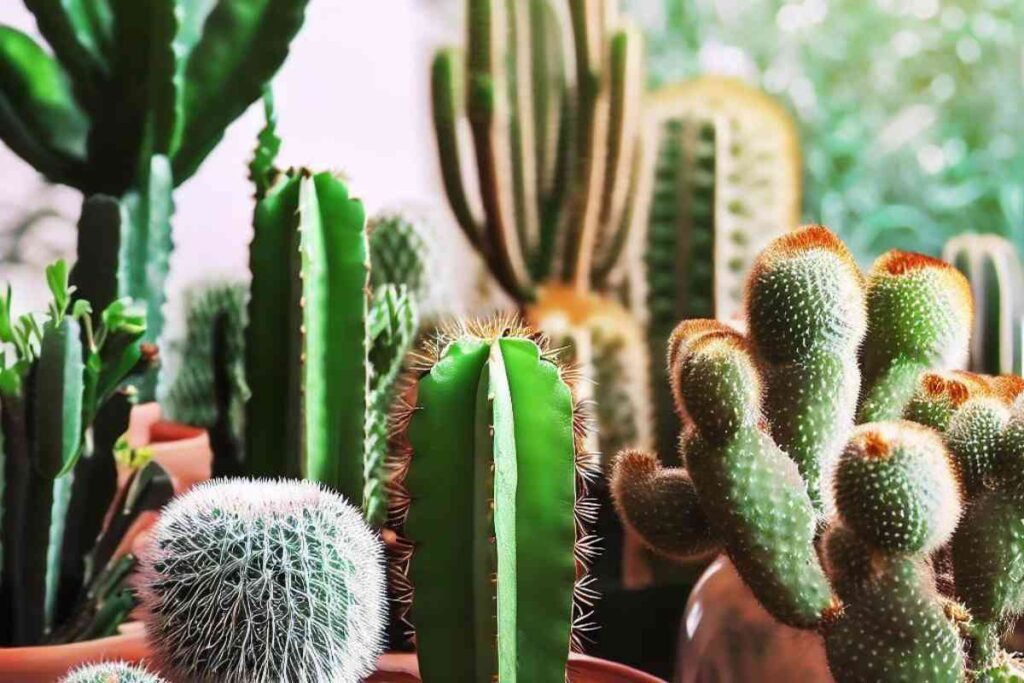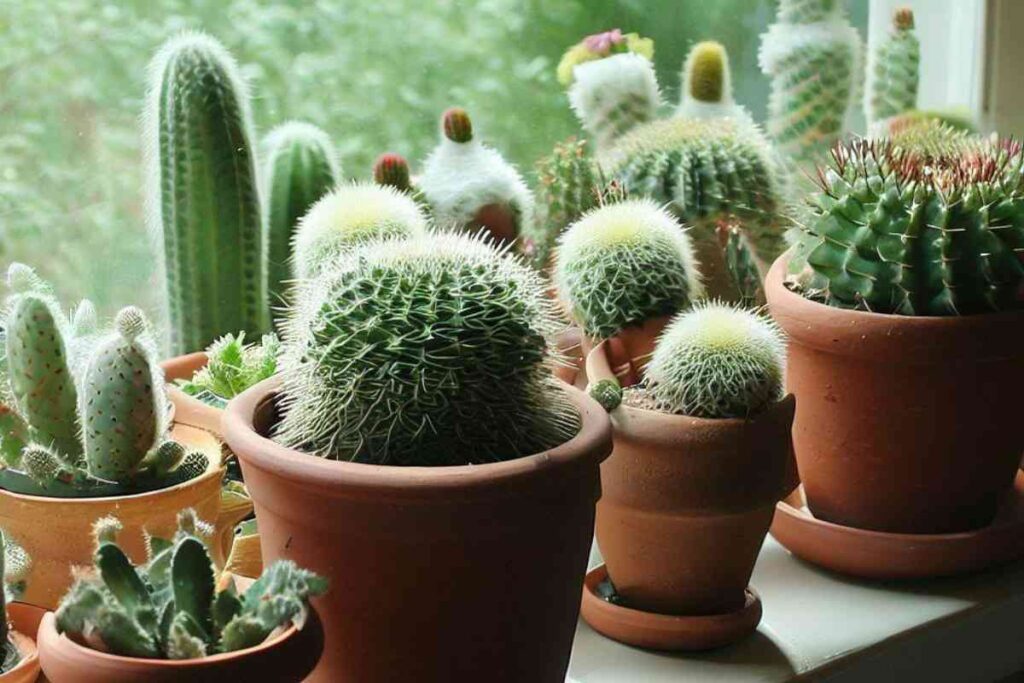Best Light for Cactus Indoors: A Comprehensive Guide

We adore those spiky little succulents but… growing cactus indoors? Yes, indoors! We know, it sounds a bit silly at first, doesn’t it?
Cacti are renowned for their ability to survive in arid, sun-soaked climates. They’re built to withstand scorching temperatures, relentless droughts, and all the challenges that come with desert living.
Does that sound like your living room? Actually, if you can get the best light for cactus indoors, the rest is easy!
What is the best light for cactus indoors?
The best light for indoor cacti is a color temperature of 6000K-6500K for 6 – 12 hours a day, depending on the species. Give your cactus bright light from a window or supplement with grow lights. HID lights are the most powerful but too expensive and hot for most home use, so LED lights are best lights for cactus indoors.
Hear us out. Who says we can’t have a little piece of the desert right here in our living rooms? Actually, it’s not hard. With the right light, cactus do great inside. Here’s what you need to know.
Why stop with cacti? Here’s your jump-start guide into the fascinating world of growing all kinds of succulents indoors.
Gardening with succulents and cacti indoors and out? These tips will make it a breeze to fill your life with succulents and cacti.
Indoor cacti bring a unique charm to any space, with their prickly spines standing tall like tiny guardians of greenery. And let’s not forget the variety of shapes and sizes they come in—some resembling whimsical sculptures, others sporting wavy patterns or vibrant blossoms that defy their prickly nature.
Not to mention, they DO NOT CARE if you forget to water them. For months. Seriously.
So, let’s turn our homes into mini deserts, our living rooms into oasis-like retreats. We just need the right light.

Understanding Cactus Lighting Needs
Cacti are unique plants that have adapted to thrive in harsh environments with very little water. Understanding the lighting needs of cacti is crucial for their growth and survival, especially when grown indoors.
Natural Light
In their natural habitat, most cactus receive intense sunlight for at least several hours a day. When grown indoors, it is essential to replicate these light conditions as much as possible. Research the light needs of your cactus. We have some common ones listed here.
Placing your cactus on a windowsill that receives direct sunlight for at least four to five hours a day is ideal. However, be careful that the sunlight isn’t concentrating through the glass and scorching your cactus. Opening the window is ideal, if possible.
Artificial Light
If you don’t have access to a sunny windowsill or live in an area with limited natural sunlight, you can use artificial light to grow your cactus indoors.
The color temperature of a grow light is measured in kelvins (K) and indicates how warm or cool the light appears. The higher the kelvins, the cooler and bluer the light. The lower the kelvins, the warmer and redder the light.

Different color temperatures can affect the growth and development of plants in different ways. Generally, plants need more blue light for vegetative growth and more red light for flowering and fruiting.
A full spectrum grow light that combines both red and blue light is ideal for most plants.
For cacti and succulents, a color temperature of 6000K-6500K is optimal for growing healthy and strong plants.
This is because this range of color temperature provides a bright and cool light that mimics the natural sunlight that cacti are adapted to.
However, some cacti may also benefit from a lower color temperature of 3500K-4500K during their flowering phase, as this can stimulate the production of buds and blooms.
It’s helpful to have a grow light that can switch between different color temperatures depending on your cactus’s growth stage.
What Kind of Grow Light Should You Choose for Cacti?
HID lights are the most powerful and can support the growth of larger cactus plants. However, HID lights are also very expensive, consume a lot of electricity, and generate a lot of heat.

LED lights are powerful, cool, and energy-efficient, and good for most cactus but a little bit expensive for hobbiests.
Fluorescent lights are cheap, fairly energy-efficient, and emit a cool, white light that is suitable for smaller cacti. On the other hand, incandescent lights emit a warm, yellow light that is not ideal for cacti.
In addition to providing the necessary light requirements, artificial light can also be used for aesthetic purposes.
You can use colored lights to enhance the appearance of your cactus and create a unique ambiance in your home.
Cactus Lighting Needs
| Bunny Ears | Bright indirect light | 6-8 hours |
| Christmas Cactus | Bright indirect to dappled light | 8-12 hours |
| Zebra Cactus | Bright, filtered light | 6-8 hours |
| Golden Barrel | Full sun to bright indirect light | 8-10 hours |
| Moon Cactus | Bright indirect light | 6-8 hours |
| Old Lady Cactus | Bright direct light | 10-12 hours |
| Mistletoe Cactus | Bright indirect to dappled light | 8-10 hours |
| Bishop’s Cap | Bright direct to indirect light | 6-8 hours |
| Easter Cactus | Bright indirect light | 10-12 hours |
| Rat Tail Cactus | Bright direct to indirect light | 8-10 hours |

Setting Up Your Indoor Cactus Lighting System
When installing your lighting system, make sure to position the bulbs at the appropriate distance from your cactus. Too much light can cause your cactus to burn, while too little light can stunt its growth.
A good rule of thumb is to place your cactus about 12 inches away from the light source, but this may vary depending on the type of bulb you are using.
Make sure to check your bulbs regularly and replace them as needed. You should also clean your bulbs and fixtures periodically to remove any dust or debris that may be blocking the light.
Monitor your cactus for signs of stress or damage. If your cactus is not receiving enough light, it may become pale or elongated. On the other hand, if it is receiving too much light, it may become burnt or discolored.
Make sure to adjust your lighting system as needed to ensure that your cactus is receiving the right amount of light.

Decision Tree: Is My Indoor Cactus Getting the Right Amount of Light?
- Does the cactus show signs of etiolation (elongation of stems, pale or yellowish color)?
- If yes, move to step 2.
- If no, move to step 4.
- Is the cactus positioned near a window or a direct source of bright light?
- If yes, it might be getting too little light. Move to step 3.
- If no, it might be getting too much light. Move to step 4.
- Assess the current light conditions:
- Is the cactus placed within 2-3 feet of a south-facing window?
- If yes, it’s likely getting adequate light, and leggy growth may be due to other factors such as overwatering or nutrient deficiency.
- If no, it might be getting too little light. Move to step 4.
- Is the cactus placed within 2-3 feet of a south-facing window?
- Examine the cactus for signs of sunburn:
- Are there yellow or brown spots, scorched patches, or bleached areas on the cactus?
- If yes, it’s likely getting too much light. Move to step 5.
- If no, it might be getting the right amount of light.
- Are there yellow or brown spots, scorched patches, or bleached areas on the cactus?
- Evaluate the distance between the cactus and the light source:
- Is the cactus placed within 1-2 feet of a south-facing window or direct sunlight?
- If yes, it’s likely getting too much light. Consider moving it to a slightly shadier location or using a sheer curtain to filter the sunlight.
- If no, the cactus may have other issues causing sunburn-like symptoms.
- Is the cactus placed within 1-2 feet of a south-facing window or direct sunlight?
Conclusion
Keep in mind that different cacti have different light needs, so it’s important to research the specific needs of your cactus before providing it with light. With the right lighting conditions, your indoor cactus can thrive and grow into a beautiful and healthy feature in your home.
